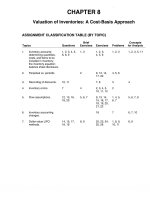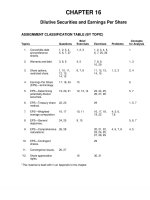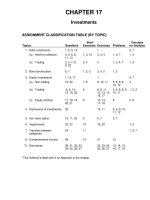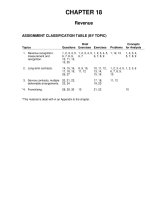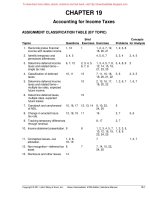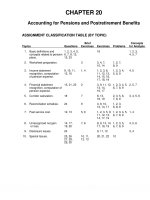Intermediate accounting IFRS 3rd ch08
Bạn đang xem bản rút gọn của tài liệu. Xem và tải ngay bản đầy đủ của tài liệu tại đây (2.09 MB, 48 trang )
Prepared by
Coby Harmon
University of California, Santa Barbara
Westmont College
8-1
Valuation of
Inventories: A CostBasis Approach
CHAPTER 8
LEARNING OBJECTIVES
After studying this chapter, you should be able to:
8-2
1.
Describe inventory
classifications and different
inventory systems.
3.
Compare the cost flow
assumptions used to account
for inventories.
2.
Identify the goods and costs
included in inventory.
4.
Determine the effects of
inventory errors on the
financial statements.
PREVIEW OF CHAPTER 8
Intermediate Accounting
IFRS 3rd Edition
Kieso ● Weygandt ● Warfield
8-3
LEARNING OBJECTIVE 1
Describe inventory
classifications and different
inventory systems.
Inventory Issues
Classification
Inventories are asset:
items held for sale in the ordinary course of business, or
goods to be used in the production of goods to be sold.
Businesses with Inventory
Merchandising
Company
8-4
or
Manufacturing
Company
LO 1
Classification
ILLUSTRATION 8.1
8-5
One inventory
account.
Purchase
merchandise in
a form ready for
sale.
LO 1
Classification
ILLUSTRATION 8.1
Three accounts
8-6
Raw Materials
Work in Process
Finished Goods
LO 1
ILLUSTRATION 8.2
Flow of Costs through
Manufacturing and
Merchandising Companies
8-7
LO 1
Inventory Issues
Inventory Cost Flow
ILLUSTRATION 8.3
Two types of systems for maintaining inventory records — perpetual
system or periodic system.
8-8
LO 1
Inventory Cost Flow
Perpetual System
1. Purchases of merchandise are debited to Inventory.
2. Freight-in is debited to Inventory. Purchase returns and
allowances and purchase discounts are credited to Inventory.
3. Cost of goods sold is debited and Inventory is credited for
each sale.
4. Subsidiary records show quantity and cost of each type of
inventory on hand.
The perpetual inventory system provides a continuous record of the
balance in both the Inventory and Cost of Goods Sold accounts.
8-9
LO 1
Inventory Cost Flow
Periodic System
1. Purchases of merchandise are debited to Purchases.
2. Ending Inventory determined by physical count.
3. Calculation of Cost of Goods Sold:
Beginning inventory $ 100,000
Purchases, net + 800,000
Goods available for sale900,000
Ending inventory
- 125,000
Cost of goods sold $ 775,000
8-10
LO 1
Inventory Cost Flow
Comparing Perpetual and Periodic Systems
Illustration: Fesmire Company had the following transactions
during the current year.
Record these transactions using the Perpetual and Periodic
systems.
8-11
LO 1
Inventory Cost Flow
8-12
ILLUSTRATION 8.4
Comparative Entries—
Perpetual vs. Periodic
LO 1
Inventory Cost Flow
Illustration: Assume that at the end of the reporting period, the
perpetual inventory account reported an inventory balance of
$4,000. However, a physical count indicates inventory of $3,800 is
actually on hand. The entry to record the necessary write-down is
as follows.
Inventory Over and Short 200
Inventory
200
Note: Inventory Over and Short adjusts Cost of Goods Sold. In
practice, companies sometimes report Inventory Over and Short in
the “Other income and expense” section of the income statement.
8-13
LO 1
Inventory Issues
Inventory Control
All companies need periodic verification of the inventory records
by actual count, weight, or measurement, with
counts compared with detailed inventory records.
Companies should take the physical inventory
8-14
near the end of their fiscal year,
to properly report inventory quantities in their annual
accounting reports.
LO 1
Inventory Issues
Determining Cost of Goods Sold
Companies must allocate the cost of all the goods available for
sale (or use) between the goods that were sold or used and
those that are still on hand.
ILLUSTRATION 8.5
Computation of Cost
of Goods Sold
8-15
LO 1
Goods and Costs
Included an
Inventory
LEARNING OBJECTIVE 2
Identify the goods and costs
included in inventory.
Goods Included in Inventory
A company recognizes inventory and accounts payable at
the time it controls the asset.
Passage of title is often used to determine control because
the rights and obligations are established legally.
8-16
LO 2
Goods Included In Inventory
Goods in Transit
Example: LG (KOR) determines ownership by applying the
“passage of title” rule.
If a supplier ships goods to LG f.o.b. shipping point, title
passes to LG when the supplier delivers the goods to the
common carrier, who acts as an agent for LG.
If the supplier ships the goods f.o.b. destination, title
passes to LG only when it receives the goods from the
common carrier.
“Shipping point” and “destination” are often designated by a
particular location, for example, f.o.b. Seoul.
8-17
LO 2
Goods Included In Inventory
Consigned Goods
Example: Williams Art Gallery (the consignor) ships various art
merchandise to Sotheby’s Holdings (USA) (the consignee), who
acts as Williams’ agent in selling the consigned goods.
Sotheby’s agrees to accept the goods without any liability,
except to exercise due care and reasonable protection from
loss or damage, until it sells the goods to a third party.
When Sotheby’s sells the goods, it remits the revenue, less a
selling commission and expenses incurred, to Williams.
Goods out on consignment remain the property of the consignor
(Williams).
8-18
LO 2
Goods Included In Inventory
Sales with Repurchase Agreements
Example: Hill Enterprises transfers (“sells”) inventory to Chase,
Inc. and simultaneously agrees to repurchase this merchandise at
a specified price over a specified period of time. Chase then uses
the inventory as collateral and borrows against it.
8-19
Essence of transaction is that Hill Enterprises is financing its
inventory—and retains control of the inventory—even though it
transferred to Chase technical legal title to the merchandise.
Often described in practice as a “parking transaction.”
Hill should report the inventory and related liability on its books.
LO 2
Goods Included In Inventory
Sales with Rights of Return
Example: Quality Publishing Company sells textbooks to Campus
Bookstores with an agreement that Campus may return for full
credit any books not sold. Quality Publishing should recognize
a) Revenue from the textbooks sold that it expects will not be
returned.
b) A refund liability for the estimated books to be returned.
c) An asset for the books estimated to be returned which reduces
the cost of goods sold.
If Quality Publishing is unable to estimate the level of returns, it
should not report any revenue until the returns become predictive.
8-20
LO 2
Costs Included In Inventory
Product Costs
Costs directly connected with bringing the goods to the buyer’s
place of business and converting such goods to a salable
condition.
Cost of purchase includes all of:
1. The purchase price.
2. Import duties and other taxes.
3. Transportation costs.
4. Handling costs directly related to the acquisition of the goods.
8-21
LO 2
Costs Included In Inventory
Period Costs
Costs that are indirectly related to the acquisition or production
of goods.
Period costs such as
selling expenses and,
general and administrative expenses
are not included as part of inventory cost.
8-22
LO 2
Costs Included In Inventory
Treatment of Purchase Discounts
Purchase or trade discounts are reductions in the selling prices
granted to customers.
IASB requires these discounts to be recorded as a reduction
from the cost of inventories.
8-23
LO 2
Treatment of Purchase Discounts
**
*
ILLUSTRATION 8.6
Entries under Gross and
Net Methods
8-24
* $4,000 x 2% = $80
** $10,000 x 98% = $9,800
LO 2
Which Cost Flow
Assumptions to
Adopt?
LEARNING OBJECTIVE 3
Compare the cost flow
assumptions used to account
for inventories.
Cost Flow Methods
Specific Identification
or
8-25
Two cost flow assumptions
►
First-in, First-out (FIFO) or
►
Average Cost
LO 3



